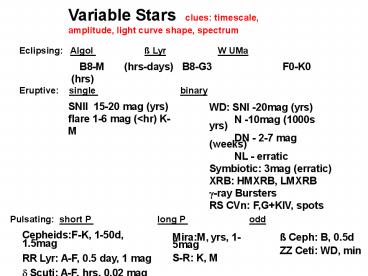Variable Stars clues: timescale, amplitude, light curve shape, spectrum - PowerPoint PPT Presentation
1 / 16
Title:
Variable Stars clues: timescale, amplitude, light curve shape, spectrum
Description:
Density profile decides how deep the pulsations penetrate in the star. (Deeper the penetration more we learn about the interior) ... – PowerPoint PPT presentation
Number of Views:69
Avg rating:3.0/5.0
Title: Variable Stars clues: timescale, amplitude, light curve shape, spectrum
1
Variable Stars clues timescale, amplitude,
light curve shape, spectrum
Eclipsing Algol ß Lyr
W UMa
B8-M (hrs-days) B8-G3
F0-K0 (hrs)
Eruptive single
binary
SNII 15-20 mag (yrs) flare 1-6 mag (lthr) K-M
WD SNI -20mag (yrs) N -10mag (1000s
yrs) DN - 2-7 mag (weeks) NL -
erratic Symbiotic 3mag (erratic) XRB HMXRB,
LMXRB ?-ray Bursters RS CVn F,GKIV, spots
Pulsating short P long
P odd
CepheidsF-K, 1-50d, 1.5mag RR Lyr A-F, 0.5 day,
1 mag ? Scuti A-F, hrs, 0.02 mag
MiraM, yrs, 1-5mag S-R K, M
ß Ceph B, 0.5d ZZ Ceti WD, min
2
Binary Evolution Roche equipotential surfaces
rc /A 0.38 0.2 log q 0.3 lt q lt 2 rc /A
0.46 (M1/M2 M1)1/3 0ltqlt0.3
3
Massive X-ray Binaries (MXRBs)
Name P (days) Sp q
Mx Vela X-1 9 B0Ia 12
1.9 Cen X-3 2.1 O7III 17
1 Cyg X-1 5.6 O9.7I 3
6
Low Mass X-ray Binaries (LMXRBs)
Name P(hrs) Sec Mx 1626-67
0.7 WD Cyg X-3 4.8 IR Her
X-1 40.8 B-F 1
4
(No Transcript)
5
long
E gt1051ergs
short
6
20M? 8M? P5 days t 1 million
yrs transfers 15M? in 30,000yrs 5M? 23M?
P11 days P 13 days t10 million yrs X-ray
binary for 10,000 yrs P 4 hrs
7
(No Transcript)
8
Cataclysmic Variables
white dwarf primary with a low mass (G-M)
secondary, orbital periods of 67 min-2 days
Nova TNR, high mass WD, outbursts 8-15 mag every
few thousand yrs
Dwarf nova disk instability, outbursts 2-7 mag
every week-30 yrs
Novalike high, low states on timescales of
months, high accretion
AM CVn 2 white dwarfs, orbital periods of 10-45
min
9
Asteroseismology
- Pulsations ? Only systematic way to study the
stellar interior - Pulsations are observed in stars all over the HR
diagram
ZZ Ceti stars
10
Pulsations in a star
- Pulsation period and amplitude depend on
- the average density. P ? ?-1/2
- Low density long P, high amplitude
- High density short P, low amplitude
- Density profile decides how deep the pulsations
penetrate in the star. - (Deeper the penetration more we learn
about the interior)
Centrally condensed stars like our Sun have
shallow pulsations Uniform density stars like
white dwarfs have deep pulsations
11
(No Transcript)
12
Cepheids and RR Lyrae
RR Lyrae A giants, Mv 0.5, Plt1 day
Cepheids F-G SG, P-L relation, HeII ionization
zone pulsation mechanism
13
P-L relation
1) measure mv with CCD 2) find P from light
curve 3) use P-L to get Mv 4) m-M d
14
Two flavors of ZZ Ceti stars (DAVs)
cool
Teff 11000K P 1000s
Larger amp, more modes, unstable amps
hot
Teff 12000K P 200s
Less modes, more stability
15
Flare Stars
Flare lt15s to 1 hr, repeats hrs - days Amplitude
up to 4 mag Opt is thermal brem at T 107K,
radio is non-thermal Between flares, spectrum is
K-M with CaII, H emission
16
- Supernovae
- A. Bhalerao - Cas A
- S. Mangiameli - SN 2006gy
- D. Wright - SN1979C
- B. Tofflemire - SN 2008D
- K. Mullins - SN 2008D
- C. Strickland - SN 2008D
- E. Lee-Wong
Pulsators T. Gomez-Polaris E. Jones-Del Scuti S.
Tinius-ZZ Cet K. Obenberger-pulsating WD T.
Rikhsiev - ZZ
Eclipsing Binaries B. Wold - SG eclipser K. Bell
- Low mass binary R. Ball - V Pup S. Hodapp -
V473 Cas, II Per
- CVs
- D. Hultengren-UX Uma
- K. Brooks -halo CV
- A. Roems -nova in M31
- M. Huang - DNO
- K. Van Keulen - VY Scl
Pulsars C. McCoy - mag neutron stars N. Gifford -
QPO in Cen X-3 N. Ramien - msec pulsar R. Vander
Giessen - LMC pulsar L. Pope - PSR J1753 J.
Bushong-PSR2021 A. Buchholz- pulsar
- Others
- K. Morgan - X-ray transients in M15
- J. Kim - Iron stars
- K. Smith - flare star CR Dra
- I. Gueorguiev - Eta Car
- C. Sayers - UW CrB
- A. Palmer, D. Grayson, M. Haefele, D. Savovic































